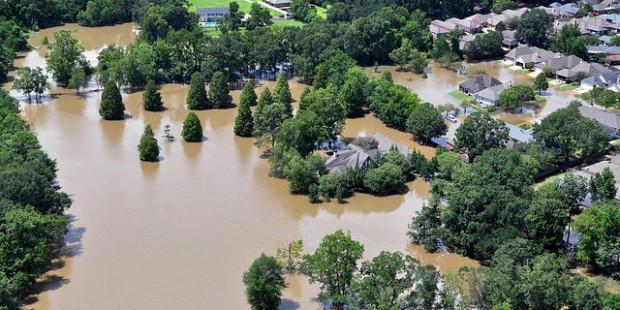3 Advantages of Steel Buildings in Flood Zones

Intense flooding can devastate a community. Just look at Baton Rouge, Louisiana in the past several days. According to a report from USA Today, 100,000 people have registered for federal emergency aid, and more than $55 million dollars have been approved to help with temporary rental assistance, home repairs and other immediate needs. Thousands of homes have become engulfed with water and are unlivable. This happens all over the United States, and when the water recedes, the true damage is revealed.
 Our thoughts and prayers are with those who try to deal with the flooding itself as well as live in the aftermath. Often times in these historic flooding events, most of the homes, garages and workshops built with wood usually cannot be saved and must be torn down. The rest can be fixed, but at great cost or with an expensive remodel.
Our thoughts and prayers are with those who try to deal with the flooding itself as well as live in the aftermath. Often times in these historic flooding events, most of the homes, garages and workshops built with wood usually cannot be saved and must be torn down. The rest can be fixed, but at great cost or with an expensive remodel.
Durability
Steel buildings, equipped with steel framing, roofing, sheeting and trim are much more suited to handle whatever Mother Nature throws at them. Steel buildings are extremely durable against strong wind, seismic activity, heavy rains, and yes, even the overabundance of water in an intense flooding event. Steel is extremely strong, and doesn’t warp, twist or bend even after sitting in murky floodwater for days or weeks.
Obviously, the main problem steel buildings must contend with is rust. However, many steel buildings come with pre-galvanized secondary framing and painted framing to protect the steel. Galvanization is the process of applying that protection from corrosion. When a piece of steel is galvanized, usually by hot-dip galvanization, it forms a coating of rust-resistant zinc. The coating thwarts destructive substances from reaching the metal. In essence, the zinc sacrifices itself and gives the steel a sort of armor, even if the steel is scraped or scratched. When shopping for steel building, you’ll want to confirm that the secondary framing, base angle, and flange bracing is pre-galvanized to prevent rust.
Steel resists mold
In addition to warping, breaking and rotting, wood framed buildings that have experienced flooding can develop mold problems that aren’t so easily washed away. Because wood is a porous material, there is no way to completely remove mold without replacing the wood entirely. Mold can be extremely hazardous to your health. Mold survives by feeding off its host and can break down the strength of a structure. This is especially true if you own a wooden pole barn because wood contains sugars, starches, proteins, and other nutrients that can function as an initial food source for mold. Mold often can’t break down the bark of a living tree, but if the bark is stripped away or is fabricated into raw lumber, the protection weakens and could give way to a mold host. Mold can be present on steel as well, but since steel doesn’t have the natural nutrients that wood does, mold needs an outside food source to grow. If mold sets in and wood begins to rot, most likely you’ll have to replace significant damage or worse – the entire structure.
With steel building components, you won’t run into an intense mold issue unless you’ve installed an outside finish or added insulation to your building. Most insulation must be dry to continue to function, but others can be extremely hard to handle after it has been exposed to water.
Save on insurance costs
You can also usually save money on insurance costs by building with steel. As a first time builder, you’re looking to protect yourself, your family and your investments against the unpredictability of the weather, especially if you happen to live in a flood zone. Insurance companies recognize the durability and lifespan of steel buildings and often times offer customers lower premiums. Dangerous weather events or natural disasters are less likely to affect steel buildings and the future repair or replacement costs are generally lower than other traditional construction methods.
Keep in mind; any natural disaster like extreme flooding may call for substantial rebuilding for any builder. However, steel framing can withstand the battering of floodwaters without significant damage, and is much easier to restore. Most builders won’t need to replace an entire structure if faced with a flooding event.
Photo courtesy: US Dept of Agriculture, Louisiana National Guard
« Wood Buildings vs. Steel Buildings: The Definitive Guide
5 Signs a Metal Building is Perfect for Your Needs »
Popular Posts

A few days ago, I had a surprising conversation with our Director of Communications. He routinely sees me flying in an out of my office, helping our creative and marketing department with specific steel building language and working with the project managers and engineers. He even told me he knows when I’m at our manufacturing… …

I don’t have to tell you money doesn’t grow on trees. You already know it takes hard work, smart budgeting, and a special kind of savviness to have wealth in your life. When you plan to build a steel building on a budget, you want to get the most for your money. That usually won’t… …

